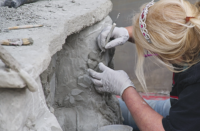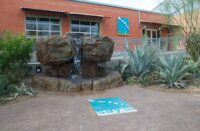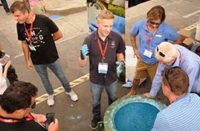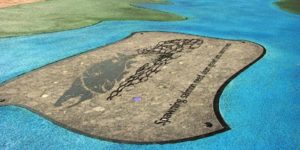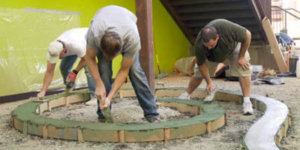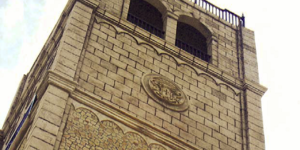 When the 2010 Concrete Decor Show was over, it left something behind — beautiful and entertaining artwork at the Children’s Museum of Phoenix. The koi pond mural and Sky Landing balcony are just a few of the exciting new features on which children are playing, thanks to artisans and exhibitors who donated time, materials and creativity.
When the 2010 Concrete Decor Show was over, it left something behind — beautiful and entertaining artwork at the Children’s Museum of Phoenix. The koi pond mural and Sky Landing balcony are just a few of the exciting new features on which children are playing, thanks to artisans and exhibitors who donated time, materials and creativity.
It all started March 31, 2009, when a team of contractors joined Show founder and Concrete Decor publisher Bent Mikkelsen to tour the old 1913 school building in downtown Phoenix that houses the Children’s Museum. The Greater Phoenix Convention & Visitors Bureau arranged the first meeting. Exhibits director Nancy Stice enthusiastically agreed to collaborate with Bent and the artisans to undertake improvements and additions.Museum president Deborah Gilpin and director of operations Lynn Walsh, identified many parts of the museum where renovations had been delayed for lack of funding, and the group explored how these areas could be improved. Ultimately the plans included two new concrete patios and renovations of two exterior sidewalks, plus floor renovations and murals inside.
The first group to come to Phoenix and complete a project — before the Show began — included University of Arkansas art professor Steven Ochs and his collaborator, Gerald Taylor of Images in Concrete. Tamryn Doolan of Surface Gel Tek provided support and arranged for students and faculty from a local high school to take part. The team completed a colorful 100-foot-long serpentine snake mural on the arrival sidewalk. The story of this project made statewide news in January 2010.
 Bob and Lee Ann Harris were also on-site in advance, setting curved forms for a courtyard patio project that would feature flagstone-stamped patterns between curving vines that radiated out from a 12-by-12 aloe vera motif at the center. Bob’s plan was to create some sections to serve as examples at a Show stamping workshop, and attendees would complete the rest.
Bob and Lee Ann Harris were also on-site in advance, setting curved forms for a courtyard patio project that would feature flagstone-stamped patterns between curving vines that radiated out from a 12-by-12 aloe vera motif at the center. Bob’s plan was to create some sections to serve as examples at a Show stamping workshop, and attendees would complete the rest.
Local volunteers from the industry jumped in to help. Journeyman finishers arrived from Local 394 of the OPCMIA, and Scottsdale-based staining contractor Ray Anger and his employee Shea Burke got to work. Pat Boyle of Phoenixbased Borders Construction Specialties provided construction supplies and even brought along his son Kevin to join the crew. Hanson Aggregates of Arizona sent a ready-mix truck and became so interested in the project they decided to donate concrete too.
As these initial projects took shape, enthusiasm at the museum and in the local community continued to build. More manufacturers decided to take on elaborate and challenging projects in advance of the event, even though they faced tight scheduling challenges working when the museum was closed.
Reaching for the sky
Shellie Rigsby of Acanthus Concrete Stain Designs designed and created the Sky Landing balcony stain project, working closely with Kemiko and the exhibits director of the museum. Dave Barreto of Kemiko describes the project this way: “Long hours, late nights and last-minute adjustments were the norm at the museum. The clock was ticking, and Shellie Rigsby’s ability to adjust and meet the requirements of the museum staff without a hitch was truly amazing to me.”
Kemiko donated decorative and industrial products to help complete Shellie’s project area. For example, since the area near an elevator is subject to high traffic, RapidShield instantcure coating system was used over the stainwork for maximum durability. Before the project started, Tamryn Doolan used her Tek Gel for profiling to remove the residue of prior floor treatments, helping the team get surface preparation done quickly with the least intrusion on the museum during operating hours. Miracote’s MPC microtopping was placed to provide a fresh working surface, since the concrete revealed was deeply gouged and uneven. Miracote staff also explained ways it could be used creatively to help create clouds and other effects.
Dave of Kemiko adds: “As we scrambled to complete the Sky Landing on the second floor, Shellie and I discovered how the color combinations were affecting the children and parents walking by. Our biggest challenge was being able to complete this project in one of the busiest high-traffic locations in the building without being able to shut it down until after hours. But the looks on the children’s faces were motivation enough.”
Miracote’s team also included some fine artists who created the faux koi pond in the museum entryway. Julio Hallack, of California-based Concrete by Hallack, and Miracote’s own Trevor Foster placed the Mirastamp system, using Proline stamps to form rock-like edges defining a pond. Then Trevor airbrushed subtle shades of blues and greens over a base of MPC to simulate the appearance of water. Muralist Shay Davis painted lifelike koi fish swimming among realistic lily pads. The finishing touch was applying Glazetop to create the effect of water.
During the Concrete Decor Show workshops March 17-19, additional improvements were completed. Trevor and Julio renovated the floor of the dark basement break room with bright springtime colors. Jeff Abrahamson of Phoenix-based Wholesale Floors demonstrated how a badly scarred and uneven area of concrete could be completely transformed with vivid colored dyes, densifiers and Diamatic grinding and polishing equipment. Bob Harris not only completed the stamped patio, but also collaborated with Dave Barreto and their workshop students to revitalize an exterior sidewalk using stains and Flattoo stencils. Tamryn Doolan conducted a graphics workshop in the arts and crafts room.
Outside, Doug Bannister and his workshop participants stamped a new concrete pad shaded by trees to form a patio that will become a place for imaginative performances by children.
Some exhibitors visiting the site expressed interest in helping provide even more renovations.
These projects were made possible through donations of time and materials by Concrete Decor Show exhibitors in collaboration with industry-leading trainers and decorative concrete contractors.
